Click on images to enlarge

infestation (Photo: Sheldon Navie)
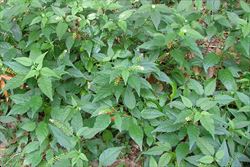
habit (Photo: Sheldon Navie)
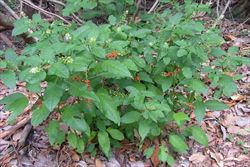
habit (Photo: Sheldon Navie)
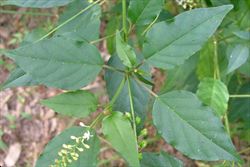
leaves with elongated tips (Photo: Sheldon Navie)

close-up of leaf underside and flower buds (Photo: Sheldon Navie)
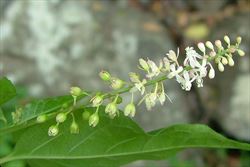
elongated cluster of white flowers, with older flowers turning greenish (Photo: Sheldon Navie)
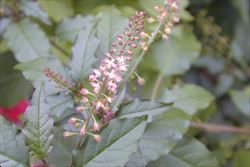
flowers are sometimes pinkish-tinged (Photo: Sheldon Navie)
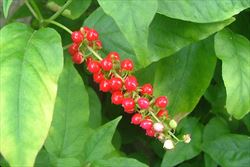
cluster of mature fruit (Photo: Sheldon Navie)
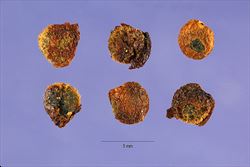
close-up of seeds (Photo: Jose Hernandez at USDA PLANTS Database)

young plant surrounded by small seedlings (Photo: Sheldon Navie)
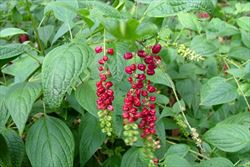
the similar native climbing deeringia (Deeringia amaranthoides), with fruit that have three indistinct furrows (Photo: Sheldon Navie)

close-up of flowers with four 'petals' (Photo: Sheldon Navie)
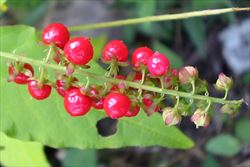
close-up of glossy red mature fruit with persistent green 'petals' (Photo: Sheldon Navie)
Scientific Name
Rivina humilis L.
Family
Phytolaccaceae
Common Names
baby pepper, blood berry, bloodberry rougeplant, coral berry, coralberry, inkberry, pigeon berry, pigeonberry, rouge plant, rouge-plant, rougeplant, small pokeweed, turkeyberry
Origin
Native to southern USA (i.e. Oklahoma, Arkansas, Florida, Louisiana, Mississippi, New Mexico, Texas and Arizona), Mexico, Central America (i.e. Belize, Costa Rica, El Salvador, Guatemala, Honduras, Nicaragua and Panama), the Caribbean and South America (i.e. French Guiana, Guyana, Surinam, Venezuela, Brazil, Bolivia, Colombia, Ecuador, Peru, Argentina and Paraguay).
Naturalised Distribution
Widely naturalised in the coastal and sub-coastal districts of eastern Australia (i.e. in eastern Queensland and north-eastern New South Wales). Also naturalised on Norfolk Island and the Cocos Islands.
Naturalised overseas in south-eastern Asia, on La Réunion and on several Pacific islands (e.g. the Galápagos Islands, Fiji, French Polynesia, Hawaii, New Caledonia and Tonga).
Habitat
This species prefers damp, shady sites and is a weed of closed forests, forest margins, riparian vegetation, disturbed sites, waste areas, urban bushland and gardens in tropical and sub-tropical regions.
Habit
An upright (i.e. erect) herbaceous plant or small shrub usually growing 0.6-1 m tall.
Distinguishing Features
- a small shrub or woody herbaceous plant that prefers damp and shady habitats.
- its alternately arranged leaves (3-13 cm long) are mostly hairless with entire margins and pointed tips.
- its whitish flowers are arranged in elongated clusters (5-15 cm long) in the forks of the upper leaves.
- these flowers have four small 'petals' (i.e. perianth segments) that turn from white or pinkish to greenish as they mature.
- its fruit small rounded berries (3-4 mm across) turn from green to bright glossy red as they mature.
Stems and Leaves
The slender stems become slightly woody with age, especially near the base of the plant. Younger stems are greenish in colour and mostly hairless (i.e. glabrous).
The simple leaves are alternately arranged along the stems and are borne on stalks (i.e. petioles) 1-5 cm long. Their blades (3-13 cm long and 1-5 cm wide) are oblong or narrowly egg-shaped in outline (i.e. narrowly-ovate) with entire margins and pointed tips (i.e. acuminate apices). They are hairless (i.e. glabrous) or sparsely hairy (i.e. puberulent).
Flowers and Fruit
The whitish flowers are arranged in elongated clusters (4-8 cm long, lengthening to 5-15 cm long in fruit) in the forks of the upper leaves (i.e. in axillary racemes). Numerous small flowers are produced in each of these clusters, each being borne on a short stalk (i.e. pedicel) 1-4 mm long. These flowers have four small 'petals' (i.e. perianth segments) 1-3 mm long and four stamens. The 'petals' are initially white or pinkish but turn greenish as they mature. Flowering occurs mostly during spring and summer.
The fruit are small rounded (i.e. sub-globose) berries that contain a single seed. These fruit (3-4 mm across) turn from green to bright shining red (occasionally orange) as they mature. The rounded seeds are 2.5-3.5 mm across.
Reproduction and Dispersal
This species reproduces by seed, which are probably dispersed by water and in mud attached to animals and vehicles.
Environmental Impact
Coral berry (Rivina humilis) is regarded as an environmental weed in Queensland and New South Wales, and as a "sleeper weed" in other parts of Australia.
Legislation
Not declared or considered noxious by any state government authorities.
Similar Species
Coral berry (Rivina humilis) may sometimes be confused with small plants of the native climbing deeringia (Deeringia amaranthoides). These two species can be differentiated by the following differences:
- coral berry (Rivina humilis) is a herbaceous plant or small shrub usually growing 0.6-1 m tall. Its flowers have four small white or pinkish 'petals' (i.e. perianth segments) 1-3 mm long and four stamens. The small bright red fruit (3-4 mm across) are somewhat rounded (i.e. subglobose) and very shiny in nature.
- climbing deeringia (Deeringia amaranthoides) is a climbing plant growing up to 4 m tall, or occasionally a small shrub. Its flowers have five inconspicuous greenish 'petals' (i.e. perianth segments) about 2 mm long and five stamens. The small bright red fruit (4-5 mm across) are somewhat rounded (i.e. sub-globose), but have three indistinct furrows.

